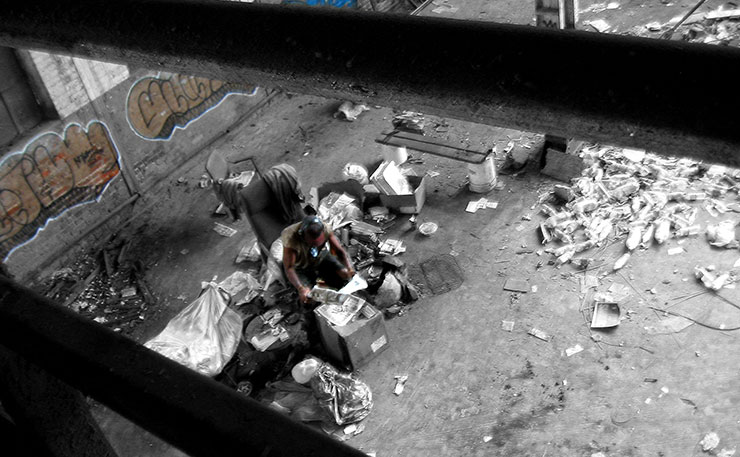How does an articulate, middle-aged highly employable – and employed – man become homeless? Nelly Thomas explains.
Before I became a comedian I worked in the welfare sector.
I spent some time working in services for the homeless, some in Family Violence refuges and some for The Council to Homeless Persons in policy and advocacy roles. Twenty years ago, the people we worked with were varied, but by and large they fitted the public’s image of homelessness: from disadvantaged backgrounds, difficult family life, addiction issues, mental health issues and entrenched poverty.
Their gender, sexuality, age, race and so on varied – they certainly weren’t all the old white guy on the park bench clutching a paper bag – but they had impossibly hard lives and often came from similar backgrounds and experiences. Women escaping family violence were the exception – they come from everywhere – and there were others, but it was very rare that someone walked in who was healthy and employed. In fact, I can’t think of a single person I worked with who had a job. That’s changed.
We’ve all heard of the working poor and how they’re affected by Australia’s cost of housing crisis.
We know the safety net has been chronically eroded. The stats show a clear and growing gap between rich and poor.
But we also know those with power are strikingly out of touch with the consequences all of this.
In the interests of putting a real face to very real concepts, my mate Craig (*not his real name) has agreed for me to tell you his story. There is no embellishment for effect; Craig and his story are true.
Craig is currently homeless. I have known him for 20 or so years and to my knowledge, this is the first time he’s been homeless. He is not sleeping rough out the front of a train station and begging you for 50c, but he has nowhere to live. At the moment Craig is housesitting for a friend for a couple of weeks, but he has spent the last few months sleeping in his car and sometimes, on the floor of a factory where his cousin works. He has friends he can stay with now and then but has been too proud to ask for help and/or reluctant to be a burden.
That’s where we are in Australia now: poor people feel like a burden.
Craig is articulate, pretty healthy (I’ll get to that) and employed. His mum is awesome but she has another son with mental health issues that she cares for. Craig was able to live with her for a time, but is unable to do so now. He also has a wonderful sister. Devastatingly, she is terminally ill, has children to care for and cannot take him in.
I tell you this because the first question I am asked whenever I mention homelessness is, “What is wrong with their family?” There is nothing wrong with Craig’s family. They love him and he loves them; they are simply poor and in poor health. And yes, the two do often go together.
So how did Craig end up homeless?
Well, his first mistake was being a do-gooder.
Craig works in disability services and currently earns about $22 per hour on a casual basis. He can’t live on that income so he also works nightshift in a factory. This leaves him with a yearly income of between $25-$40k, give or take, and depending on the year. He was travelling along reasonably well – if working two jobs at close to minimum wage can be considered reasonably well – until last year, when he developed a heart condition and was hospitalised for a long period. While in hospital he lost his job and housing.
I’d ask you to pause for a minute and take that in – while Craig was in hospital for a heart condition, he was evicted and lost his job. If the Australian “safety net” can’t protect your employment and housing for a few months while you’re sick, it’s well and truly broken.
The real kicker is that the surgeon – from whom he received excellent care via the public system and for which we should all fight tooth and nail – told him that overworking was the most likely cause of the supressed immune system that left him vulnerable to the health crisis in the first place.
Ai, Ai, Ai.
Craig has now recovered and is employed again, working two jobs in order to save to get a place. He recently applied for a one-bedroom apartment in a middle suburb (about 12 kms from the CBD Melbourne). If he got the place, he would have paid $270 a week. But he didn’t get it. The real estate agent didn’t even forward his application to the owner; she literally said his bank account wasn’t “healthy enough.” No pun intended.
Again, a pause. Craig is not seeking a warehouse conversion in a trendy suburb, but rather, a one-bedroom apartment on a busy road, in the suburbs, for ALMOST $300 PER WEEK. No wonder we have a homelessness crisis.
Craig’s other outgoings are modest, but if he gets a flat around that price – and assuming his hours at work are maintained and he can manage to work them – he’ll be left with about $50 a week “discretionary spending”. If he can’t keep working and needs to go on sickness benefits he will receive $264.35 per week or $5.65 less than his rent.
He’ll get a bit of Rent Assistance though so it will all be fine as long as he doesn’t have to eat, pay bills or go anywhere. God help him if his car breaks down or he needs a haircut or something.

So, how do we get here? How do we get to a place where a person who is qualified, employed, middle-aged and working in a profession that is universally admired – the care and support of people with disabilities – ends up homeless and at risk of ongoing homelessness?
The short answer is: inadequate funding of essential services, corporatisation of the welfare sector, casualisation of the workforce, erosion of workers’ entitlements, deregulation and neglect of the social security safety net (we could also add the rise of chronic individualism and maligning of the poor – both of which make people like Craig extremely vulnerable and reluctant to ask for help because they and others internalise the idea that poverty and homelessness are somehow individual failings and not community ones; but we don’t have time).
Let’s start with his employment. In real terms Craig’s hourly rate has barely increased in 10 years. A couple of decades ago, the Victorian Government deregulated the welfare sector, devolved the provision of essential services to Church groups and NGOs and introduced the concept of competition. Essentially it meant large and small welfare providers started to battle for government contracts to provide services to the disadvantaged.
This was genius. It meant the do-gooders now competed with each other to lower the cost of service provision, there was someone to blame when something went wrong (arms length, I believe they call it) and some of the governments’ biggest critics were effectively shut up.
Corporate ideology about competition, the market, clients, flexibility and my personal favourite – efficiency – was swallowed hook, line and sinker. Carers became commodities and the cared for became consumer/clients.
Vulnerable people were required to become efficient and care of them became a business.
So, Craig’s wage, give or take, is currently about $22 an hour. He has 15 years experience and works with people with a range of disabilities, many of whom have multiple physical and mental illnesses and complex needs. The figures on wage rates are illuminating: a bar tender or cleaner in Victoria gets about $20.49 an hour, a teacher about $32, a tradie about $30 (average people, some much higher!) and a CEO about $90 (again, average). If Craig had worked for 15 years at MacDonald’s, he’d likely be earning 1.3 times as much as he does now.
What does Craig do for his $22 an hour? Basically, in-home and community care for men with disabilities. He does things like take them food shopping, to medical appointments, to the movies, bowling and so on. He helps with things as diverse as nit treatments to neighbour disputes to showering to dentist visits. For many of these men, he is literally the only person they see in a week or fortnight.
Craig also takes a lot of the guys on leisure activities. He’s not into the zoo or Timezone, but he goes there a lot. That’s fine, it’s part of the job, but in addition to his real wage reduction and loss of entitlements, Craig now has to do these things on HIS OWN DIME. That’s right, the out-of-pocket costs associated with the leisure activities FOR HIS CLIENTS are no longer funded as part of the fee-for-service contract his employer accepted, so he has to either ask his client to pay, or pay himself. You can guess which is more likely.
It’s bad enough that a guy who’s into Felini films has to watch Moana, but to ask him to pay for it? Bloody torture.
To add insult to injury, Craig has lost other work-related reimbursements. For example, he is no longer paid for out of contact phone calls or travel time between clients. Some of the guys he works with live 30kms apart and/or require someone to deal with various officials for them. Craig is only paid for time he actually spends with the clients so while he’s sitting on the freeway or on the phone to Centrelink, it’s at his expense.
Then there’s the paperwork. Paperwork is to welfare workers what dirty towels on the floor are to parents of teenagers: a never-ending Sisyphean headache. It’s a necessary and important task, but SURPRISE; he is no longer funded to do that either! Adequate time used to be allocated for intake and record keeping, but Craig and his co-workers were issued a directive a few years ago to do this stuff on client time. Which is obviously pretty much impossible and, besides, reduces their quality of care so is unethical.
In short, I asked Craig to estimate the amount of time he spends working for free and he just smiled.
I wanted to punch someone.
To be clear, Craig doesn’t even mind his low hourly rate or reimbursement restrictions (I bloody do, but that’s a whole other story): what he minds most is the loss of worker entitlements.
Back in the day when his work was better funded, he was employed as a full-time worker on a fixed contract with sick pay, holiday entitlements and weekend/public holiday loading. Once greater competition was introduced and fee-for-service jobs – like NDIS contracts – became commonplace, he was casualised along with almost everyone he works with. His hourly rate has stagnated and the number of hours he is paid for has been reduced. So, he earns a pittance and has no idea how much he’ll earn week to week.
Some of you may be thinking that Craig’s employer is shit. Personally I’d concur but we must remember that the entire welfare sector (and many other sectors) has effectively been deregulated. As I said previously, individual welfare providers now compete in a marketplace. This is super efficient (in that it drives the costs down) but it obviously also lessens the quality of care and comes at the expense of workers in the Australian welfare sector – they literally pay.
And so people, we arrive at a situation whereby a guy who has dedicated his life to helping others now requires help. This efficient system has made the carer the cared for.
If Craig falls into long-term homelessness he’ll cost the community between $15,000 and $35,000 per year; and that doesn’t include his loss of productivity or tax revenue. Add the Centrelink benefits he’ll need to that and we’re getting close to a bloody wage!
In other words, put aside the sheer immorality of it all, the government could literally give Craig a salary to prevent his homelessness and still be ahead. If they just ensured decent wages and conditions in the first place then he – and the tax payer – could be saved the trouble.
Craig will be ok. He is healthy(ish), smart, resourceful and has friends who can help him.
He is one of the lucky ones.
But if his story tells you anything, it’s that we are at a critical stage in Australia about who and what we value. The working poor are not a concept to be debated, but very real people doing very real and critical jobs.
Politicians, employers, landlords: it’s time you got your heads out of the sand and saw them.
Donate To New Matilda
New Matilda is a small, independent media outlet. We survive through reader contributions, and never losing a lawsuit. If you got something from this article, giving something back helps us to continue speaking truth to power. Every little bit counts.





